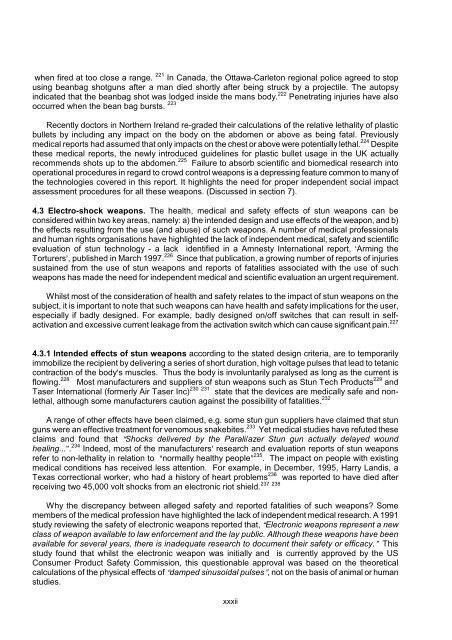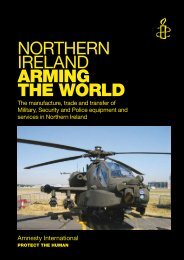CROWD CONTROL TECHNOLOGIES - Omega Research Foundation
CROWD CONTROL TECHNOLOGIES - Omega Research Foundation
CROWD CONTROL TECHNOLOGIES - Omega Research Foundation
Create successful ePaper yourself
Turn your PDF publications into a flip-book with our unique Google optimized e-Paper software.
when fired at too close a range. 221 In Canada, the Ottawa-Carleton regional police agreed to stop<br />
using beanbag shotguns after a man died shortly after being struck by a projectile. The autopsy<br />
indicated that the beanbag shot was lodged inside the mans body. 222 Penetrating injuries have also<br />
occurred when the bean bag bursts. 223<br />
Recently doctors in Northern Ireland re-graded their calculations of the relative lethality of plastic<br />
bullets by including any impact on the body on the abdomen or above as being fatal. Previously<br />
medical reports had assumed that only impacts on the chest or above were potentially lethal. 224 Despite<br />
these medical reports, the newly introduced guidelines for plastic bullet usage in the UK actually<br />
recommends shots up to the abdomen. 225 Failure to absorb scientific and biomedical research into<br />
operational procedures in regard to crowd control weapons is a depressing feature common to many of<br />
the technologies covered in this report. It highlights the need for proper independent social impact<br />
assessment procedures for all these weapons. (Discussed in section 7).<br />
4.3 Electro-shock weapons. The health, medical and safety effects of stun weapons can be<br />
considered within two key areas, namely: a) the intended design and use effects of the weapon, and b)<br />
the effects resulting from the use (and abuse) of such weapons. A number of medical professionals<br />
and human rights organisations have highlighted the lack of independent medical, safety and scientific<br />
evaluation of stun technology - a lack identified in a Amnesty International report, Arming the<br />
Torturers, published in March 1997. 226 Since that publication, a growing number of reports of injuries<br />
sustained from the use of stun weapons and reports of fatalities associated with the use of such<br />
weapons has made the need for independent medical and scientific evaluation an urgent requirement.<br />
Whilst most of the consideration of health and safety relates to the impact of stun weapons on the<br />
subject, it is important to note that such weapons can have health and safety implications for the user,<br />
especially if badly designed. For example, badly designed on/off switches that can result in selfactivation<br />
and excessive current leakage from the activation switch which can cause significant pain. 227<br />
4.3.1 Intended effects of stun weapons according to the stated design criteria, are to temporarily<br />
immobilize the recipient by delivering a series of short duration, high voltage pulses that lead to tetanic<br />
contraction of the bodys muscles. Thus the body is involuntarily paralysed as long as the current is<br />
flowing. 228 Most manufacturers and suppliers of stun weapons such as Stun Tech Products 229 and<br />
Taser International (formerly Air Taser Inc) 230 231 state that the devices are medically safe and nonlethal,<br />
although some manufacturers caution against the possibility of fatalities. 232<br />
A range of other effects have been claimed, e.g. some stun gun suppliers have claimed that stun<br />
guns were an effective treatment for venomous snakebites. 233 Yet medical studies have refuted these<br />
claims and found that )Shocks delivered by the Parali/azer Stun gun actually delayed wound<br />
healing...(. 234 Indeed, most of the manufacturers research and evaluation reports of stun weapons<br />
refer to non-lethality in relation to )normally healthy people( 235 . The impact on people with existing<br />
medical conditions has received less attention. For example, in December, 1995, Harry Landis, a<br />
Texas correctional worker, who had a history of heart problems 236 was reported to have died after<br />
237 238<br />
receiving two 45,000 volt shocks from an electronic riot shield.<br />
Why the discrepancy between alleged safety and reported fatalities of such weapons? Some<br />
members of the medical profession have highlighted the lack of independent medical research. A 1991<br />
study reviewing the safety of electronic weapons reported that, )Electronic weapons represent a new<br />
class of weapon available to law enforcement and the lay public. Although these weapons have been<br />
available for several years, there is inadequate research to document their safety or efficacy.( This<br />
study found that whilst the electronic weapon was initially and is currently approved by the US<br />
Consumer Product Safety Commission, this questionable approval was based on the theoretical<br />
calculations of the physical effects of )damped sinusoidal pulses(, not on the basis of animal or human<br />
studies.<br />
xxxii




